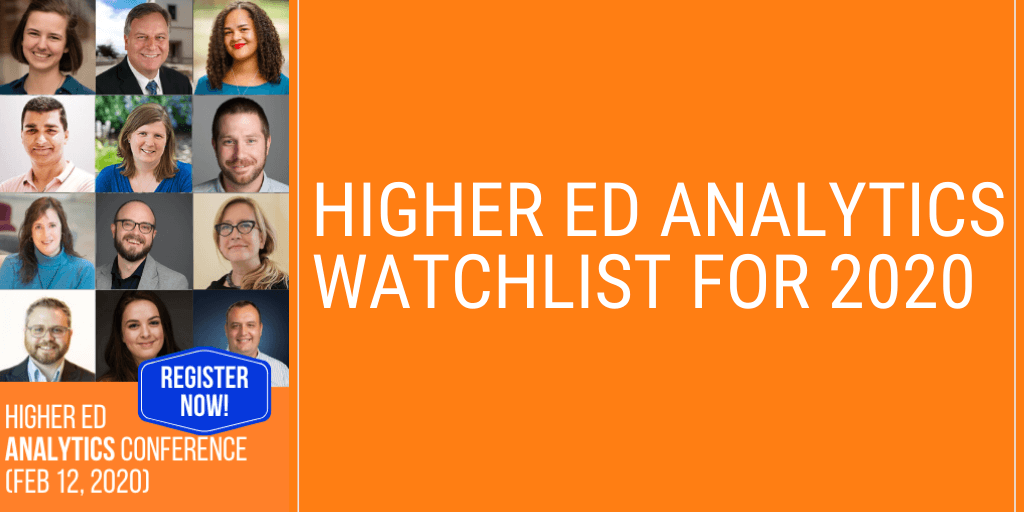What’s coming in 2020 for higher ed analytics and measurement?
I’m sure you’d love to know as much as I do. Don’t we all?
There are so many possibilities… and still so many challenges when it’s time to measure the impact of digital marketing initiatives in higher education.
So, I asked the 12 higher ed speakers of the 2020 Higher Ed Analytics Conference to play the prediction game and answer this big question as they share their plans for 2020.
Focus on enrollment data for Dr. Nicholas Ladany (USD)
 Nationally, there is a worrisome trend that more and more colleges and universities on the precipice of significant enrollment challenges, and in fact, are in danger of closing in the coming years. The colleges and universities that are able to first collect the data necessary to understand the state of enrollment, and then use the data to stem the potential dip, will be the ones that survive and most likely to thrive in the coming decade. There is not much time to address enrollment challenges but there is hope for those with forethought.
Nationally, there is a worrisome trend that more and more colleges and universities on the precipice of significant enrollment challenges, and in fact, are in danger of closing in the coming years. The colleges and universities that are able to first collect the data necessary to understand the state of enrollment, and then use the data to stem the potential dip, will be the ones that survive and most likely to thrive in the coming decade. There is not much time to address enrollment challenges but there is hope for those with forethought.
Over the next 12 months we will be deepening our focus on the link of our application analytics with use of scholarship allocation. We believe that this work will further enhance our student yield rate.
Focus on business data for Corynn Myers (University of Michigan)
 Business data. I have peers who cringe at this term because they believe it suggests we must swap our socially responsible framework for a profit-driven corporate mindset.
Business data. I have peers who cringe at this term because they believe it suggests we must swap our socially responsible framework for a profit-driven corporate mindset.
This is definitely not the case, but we must be realistic in our approaches. With higher ed headed for a prospective student cliff, trying to keep the lights on will become a very real reality. So, each and every campaign, social media channel, print piece and other communication efforts should be evaluated and scrutinized through the lens of business data.
Does this effort play a part in helping us achieve institutional goals? How do you know? Does this effort have measurable ROI?
It’s no longer enough to check a box, all marketing efforts should be intentional and measurable.
How do we get there?
Step 1: hire data-first marketers.
Step 2: put marketers at the table when strategic initiatives and planning occur
Step 3: break down silos, specifically data silos
Here @UMich we are trying really hard to take marketing out of the restrictive box it’s been in for so long. Marketing is like 10% paid media strategy and 18,461% everything else. Marketing is truly everything and we are proving that over and over again through campaign successes, educating our own leadership and our peers and constantly talking about all the data, optimizations and elements required to be successful.
AI-driven analytics for Avinash Tripathi (Kaplan Higher Education)
 It is no secret that organizations have been increasingly turning to advanced analytics and artificial intelligence (AI) to improve decision making across business processes.
It is no secret that organizations have been increasingly turning to advanced analytics and artificial intelligence (AI) to improve decision making across business processes.
I plan to focus in 2020 on how we can leverage AI-driven analytics in education to help spot critical trends to design effective classroom experience and drive digital transformation. This will also help ensure that the course content we deliver remains relevant and actionable.
MMM and MTA for Orion Stavre (WPI)
 Proving Value and ROI is becoming increasingly more important in the higher ed space, and things like MMM (marketing mix modeling) or MTA (multi-touch attribution) which have been common practice in other industries, are starting to be used in higher ed.
Proving Value and ROI is becoming increasingly more important in the higher ed space, and things like MMM (marketing mix modeling) or MTA (multi-touch attribution) which have been common practice in other industries, are starting to be used in higher ed.
Having a clear view of customer journey through data systems is the most crucial way to clearly evaluate your marketing and sales activities/channels and understand what is working.
I think the biggest opportunity for analytics and measurement for 2020 will continue to remain data integration across the marketing and sales funnels, in order to be able to achieve a clearer view of the “customer” journey. At WPI, we will continue to break silos between various recruitment, fundraising and marketing business units. This will allow for more complete analytics and measurement across the “customer” experience enabled by better data and operational integration.
Compliant data privacy policies for Kris Hardy (Messiah College)
 With the recent signing of the California Consumer Privacy Acts (CPPA) this October, it’s clear that data privacy will continue to play a big role in analytics in Higher Ed.
With the recent signing of the California Consumer Privacy Acts (CPPA) this October, it’s clear that data privacy will continue to play a big role in analytics in Higher Ed.
Understanding these types of laws and being proactive in ensuring our data collection methods and web privacy statements are compliant will be at the forefront at my institution.
Data hygiene for Emily Gustafson (Cornell University)
 2020 should bring a focus on data hygiene and integration in higher education. Stanford’s way ahead of the curve. They’ve been working to simplify and clean up their data and analytics processes for a while now, and that should be everyone’s goal. A lot of larger schools are moving towards using marketing automation and CRM – the only way that can be done is with great data hygiene and solid reporting processes already in place.
2020 should bring a focus on data hygiene and integration in higher education. Stanford’s way ahead of the curve. They’ve been working to simplify and clean up their data and analytics processes for a while now, and that should be everyone’s goal. A lot of larger schools are moving towards using marketing automation and CRM – the only way that can be done is with great data hygiene and solid reporting processes already in place.
Clickstream data analysis for Mandee Englert (Penn State University)
 I think that Clickstream Data Analysis will become a trend in higher education.
I think that Clickstream Data Analysis will become a trend in higher education.
Institutions will begin to look at that user-level data that can help to answer the most important questions like which marketing efforts are able to drive the most applications, that sources like Google Analytics/Adobe Analytics are not able to readily answer.
We plan on focusing our efforts on gaining insights from the vast amount of data already available to us by continuing to connect these data points so that we can understand a user’s journey from their first touch on one of our websites all the way to becoming a student at the University.
On-page behavior tracking for Elicia Dennis (University of Notre Dame)
 I see user behavior tracking within pages being a field that expands in 2020 as demand for more page-specific information increases.
I see user behavior tracking within pages being a field that expands in 2020 as demand for more page-specific information increases.
In the next year, I hope to further implement Google event tracking on our websites to monitor site visitor engagement with key elements on our pages. I am also exploring adding heatmaps and session recordings to our analytics toolkit. Heatmaps and event tracking are resources I learned about from other web strategists over the last year.
Overall, I’m looking to learn more about which elements on websites work well and which aren’t being used. I will use this to be more deliberate in how we prioritize content into our next round of website redesigns.
Clearer CTAs for Tatjana Salcedo (University of Vermont)
 I think that as analytics becomes a bigger part of the higher ed web picture, we are going to keep seeing more emphasis on content that includes clearer calls to action and conversion points.
I think that as analytics becomes a bigger part of the higher ed web picture, we are going to keep seeing more emphasis on content that includes clearer calls to action and conversion points.
I call it the shift from “choose your own own web journey” towards a more guided experience. At my institution, we are already adding more transactional content and rethinking both the admissions and enrolled students journey.
Personalization for Laura Montgomery (The New School)
 This has been the next big thing for a few years already, but I forsee the importance and value of personalized digital experiences continuing to grow.
This has been the next big thing for a few years already, but I forsee the importance and value of personalized digital experiences continuing to grow.
Moreover, very few institutions have yet harnessed the full potential of analytics for the sake of personalization – for example, using digital behavior markers to create audience segments and serve up content and messaging that is tailored to those specific segments. Here at The New School we’ve been able to develop some pretty sophisticated models that identify discrete segments of our prospective student target audience — and over the next 12 months we plan to do more to actually act on that information and deliver personalized content experiences.
Increased analytics expertise for Joshua Dodson (VisionPoint Marketing)
 As an industry, we still haven’t connected all of the right pieces of data so that we can have a solid and holistic perspective of what is happening in the higher ed space. Some schools certainly are able to see the downstream impact of their overall enrollment marketing efforts, but most still have not connected all of the dots.
As an industry, we still haven’t connected all of the right pieces of data so that we can have a solid and holistic perspective of what is happening in the higher ed space. Some schools certainly are able to see the downstream impact of their overall enrollment marketing efforts, but most still have not connected all of the dots.
This is the next big thing in higher ed analytics — and it isn’t just a fad, either. Comprehensive data literacy will soon be a requirement to stay competitive in a very crowded higher ed market.
Increased benchmarking practices for Aaron Baker (Harvard University)
 I think higher education institutions have gotten the message about the importance of measurement planning, and setting realistic expectations for website and social media post performance metrics. What I anticipate we’ll see in 2020 is a wider adoption of benchmarking in practice.
I think higher education institutions have gotten the message about the importance of measurement planning, and setting realistic expectations for website and social media post performance metrics. What I anticipate we’ll see in 2020 is a wider adoption of benchmarking in practice.
For me, even though we’ve been doing rough benchmarking for a couple of years, I want to focus on making it easier to have more granular expectations. For example, right now with our current benchmarks, I have a rough idea how many pageviews a news story will get, or impressions a social post will get. But more and more I’m being asked for benchmarks by content category, or benchmarks by tag, school, post type, etc.
A conference focusing on higher ed analytics?
The 2020 Higher Ed Analytics Conference (#HEA20) is a must-attend event for higher ed marketing professionals and teams looking for inspiration, ideas and best practices to step up their analytics and measurement game in 2020
Read below what your higher ed colleagues who attended the past editions of the Higher Ed Analytics Conference said about their experience.
Tags: HEA20, Higher Ed News, Karine Joly